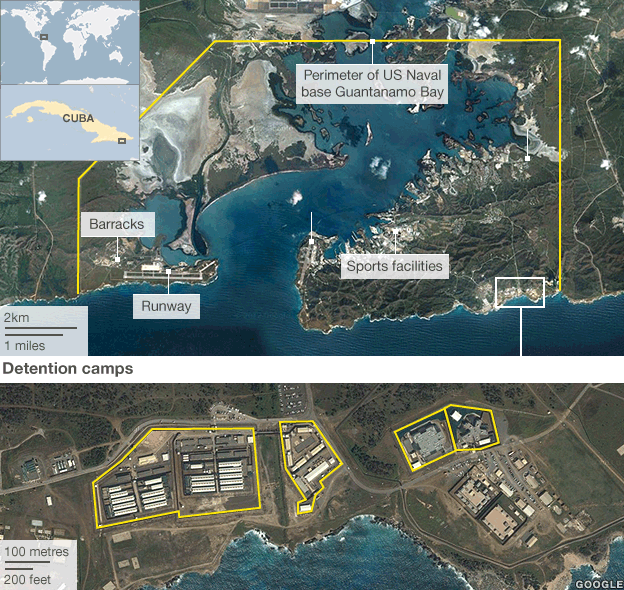Guantanamo's asymmetric war as hunger strike continues
- Published
Jonathan Beale visits "Camp Five" where the Guantanamo hunger strike started
A hunger strike at at the US military prison at Guantanamo Bay, which started with a handful of prisoners, has now become a mass protest with 103 out of the 166 detainees still held here taking part.
On Wednesday night, the number of those detainees being "force-fed" rose to 41 - up from 38 just 24 hours ago.
The protest began in February and has been growing for almost four months. Lawyers representing detainees say it was sparked by tougher prison searches.
The US military, which runs the camp, says those searches uncovered various contraband items, including homemade weapons that have been used to attack prison guards. The detainees' lawyers claim that during those searches the Koran was mishandled - something the US military strongly deny.
"Zac", the US military's "cultural adviser" who liaises with the prisoners, says it is a familiar tactic to attract the attention of the outside world. Prisoners, many of whom have been held here for more than a decade, most without charge, do not want to be forgotten.
We were shown around empty cells and the communal areas of Camps Five and Six. On previous visits, we have been allowed to watch the detainees mingle together from a distance. Over the years, the harsh regime appeared to have been relaxed.
Journalists who visit Guantanamo are still not allowed to identify or talk to the detainees. This time, though, we were kept well away from those being held. The nearest we came was during early-morning prayers when we were able to hear, but not see, them behind their heavy cell doors.
Most prisoners are now locked up, on their own, for 22 hours a day. The old privileges of communal living are being denied to all but a few - around 20 of the so-called "compliant detainees".
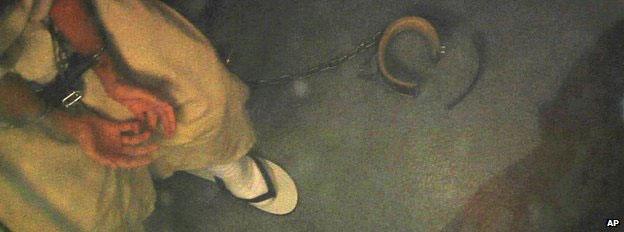
Shackles are called "humane restraints" and force-feeding is a banned word, too
It was US President George W Bush's administration that invented a new language and new rules to justify Guantanamo's existence as a camp for "unlawful enemy combatants" - without the long-established rights of "prisoners of war" .
'Enteral feeding'
Though they now apply the Geneva Conventions at Guantanamo, old habits appear to die hard. So shackles used to restrain detainees are never called that. They are simply referred to as "humane restraints". Force-feeding is also a term that is avoided. Here it's called "enteral feeding".
We were shown around the medical centre where some of those prisoners are fed nutritional supplements to ensure they survive and maintain a safe body weight. As with the camp guards, the medical staff did not want to be identified.
Faces cannot be filmed and their name tags have been removed. Instead, the medical staff have adopted fictional names from the plays of William Shakespeare. The medics say it allows them to maintain a relationship with the patients they are treating. An extra 37 medical staff have recently been flown out to Guantanamo to help deal with the growing hunger strike.
The Senior Medical Officer (SMO), explains the procedure for what he calls "enteral feeding". A tube is inserted up the nose of the detainee and then fed down the throat into the stomach to deliver the nutritional supplement. This takes place twice a day - the tube is inserted and extracted each time.
A former detainee, Omar Deghayes, who took part in earlier hunger strikes before he was released from Guantanamo five years ago, says it is painful. He likens it to the sharp pain caused by a knife. But the medical staff here insist it is humane. Olive oil is often used to ease the passage of the tube.
Recently, the military medical staff have been willing to show the restraining chair used to strap down prisoners as they are force-fed. It is no longer a secret.
The staff, who clearly have a challenging job, insist the chair is not just for their own safety, but to help the prisoner with the process.
Camp Justice
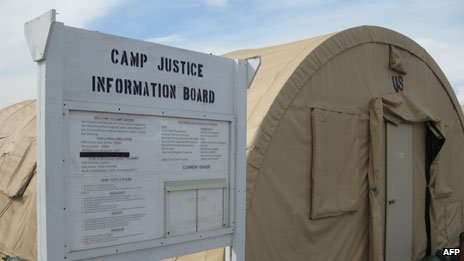
1/2. A number of Guantanamo detainees have been tried by military commission at Camp Justice. Tents on an old runway house lawyers, activists and journalists during the hearings, which are held in a former airfield building. (Click image for next slide)

2/2. Canadian-born Omar Khadr was 15 when he was arrested for an attack on a US soldier in Afghanistan in 2002. He was held and tried at Guantanamo, where he pleaded guilty to murder in violation of the law of war and other charges. In September 2012, he was returned to Canada to serve the rest of his sentence.
Camp X-Ray
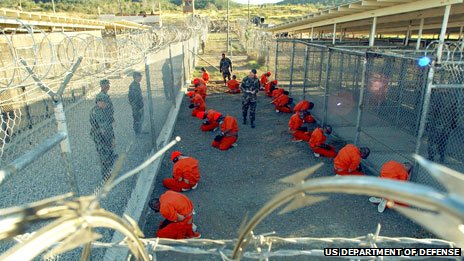
The first detainees to arrive at the Guantanamo prison in 2002 were held in the open cages of Camp X-Ray. The camp is no longer used and detainees are held in the detention complex to the south.
Camp 6
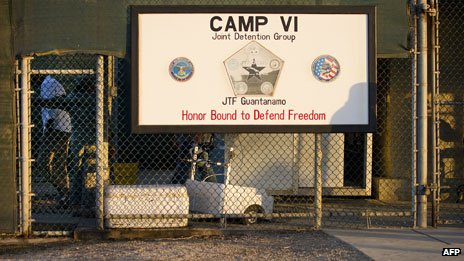
1/3. Camp 6 is a medium-security facility where detainees are held in individual cells. At least 60 detainees are believed to be held here. (Click image for next slide)

2/3. There are communal areas where detainees could congregate and take classes, as well as having access to a large recreation area 22 hours a day. (Click image for next slide)
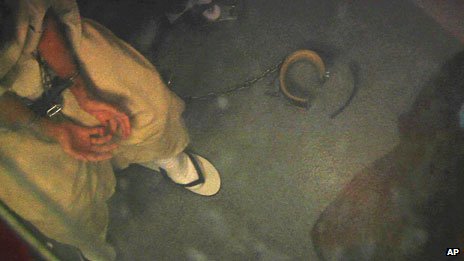
3/3. Detainees are currently being kept in their single cells for 22 hours a day.
Camp 5
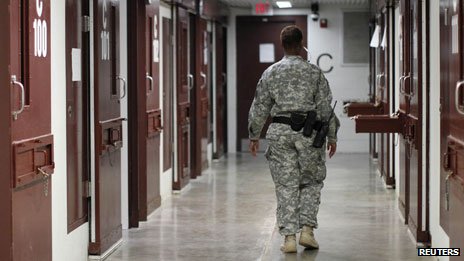
1/3. Camp 5 is where the most non-compliant and hostile detainees are held. The facility has been built with many features that can be found in maximum-security prisons in the United States. About 80 detainees are reported to be in Camp 5. (Click image for next slide)
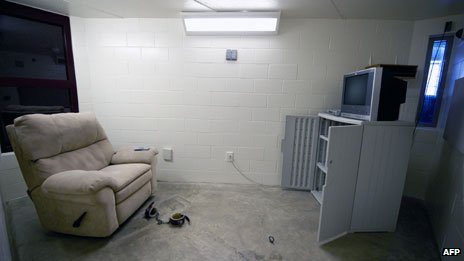
2/3. The main building has special interrogation cells, solitary entertainment cells with an ankle shackles and open-air, cage-like recreation areas. (Click image for next slide)
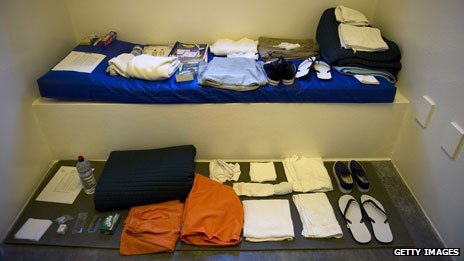
3/3. Attached to Camp Fve is Camp Echo for detainees who have co-operated with the US Government and provided information. They are under protection. The cells have steel doors instead of wire mesh.
Camp Delta
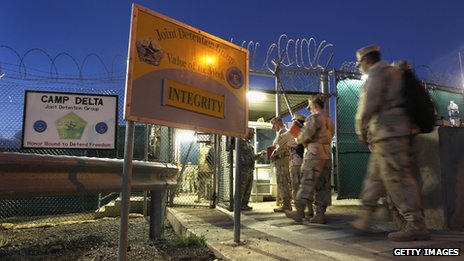
Camp Delta - made up of three camps - was built to provide more permanent facilities to replace Camp X-Ray. In 2006, three detainees were found hanging in their cells. The camp is no longer used to hold detainees but does house the detainee hospital library.
Camp 7
Camp 7 is a secret camp within the detention complex, and few details are available. Sixteen individuals are being held in Camp 7.
Camp 4

Camp 4 was designed to be a pre-release detention area with dormitory-style rooms, communal showers and eating areas. In 2006, detainees attacked guards as they responded to staged suicide attempt. The facility was closed for repairs in 2011 but has not been reopened.
A surgical mask is sometimes placed over the detainee to prevent them from spitting out the nutritional supplement. Still the SMO insists that it is really not force-feeding because the prisoner always has a choice to swallow the formula orally without the need for the tube.
The SMO says that some detainees are only taking part in the hunger strike because of peer pressure. He also claims that some have been advised to go on hunger strike by their lawyers to raise their plight in the media. He adds the tactic seems to be working because of the recent increase in requests for media visits.
'Go home'
Nevertheless, the process of force-feeding has been condemned by the United Nations and the American Medical Association. They say it is a betrayal of medical ethics. The military staff, though, who carry out the procedure, says it would be unethical to allow a patient to starve. The US military insists that it is legal and complies with the same practice carried out in federal prisons.
The goal is clearly to ensure that none of the prisoners dies. One detainee has been on hunger strike for more than five years. The camp's psychologist says many of those refusing meals are suffering from depression. But few are willing to seek help.
That sense of defiance was borne out as we were escorted quickly around Guantanamo. In Camp Six, we heard one detainee shouting out in protest. Later, a few prisoners appear to catch a glimpse of our presence from behind the screens that are used to block their line of sight.
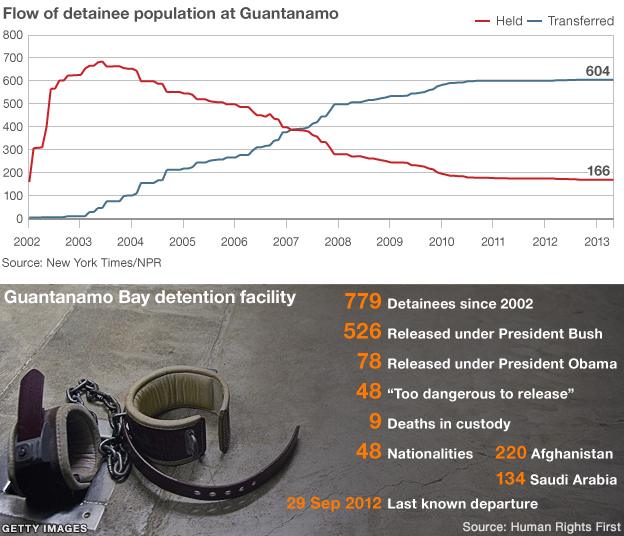
We hear one shout out : "Don't believe what they're saying… We're all on hunger strike here in the name of freedom and justice."
Another voice adds in more faltering English: "We are safekeeping the hunger strike, we don't see any change" - clearly an attempt to contradict any message from their captives that the situation is all under control.
I ask the camp commander, Col John Bogden, why he thinks so many are taking part in this protest. He says their "initial issues were to do with some changes in the camp rules". But he adds the main reason for the protest is that "they want to go home".
President Barack Obama's recently renewed pledge to close down Guantanamo, one that he originally made five years ago, may have given them hope that an end may be in sight. Yet no-one yet knows how he will be able to fulfil his promise or how this hunger strike will end.
In the meantime, Col Bogden says he will continue following his orders. I ask if he considers whether this hunger strike is part of what has been described as an "asymmetric war".
"I think that's probably an accurate description of what they do. I mean, there are plenty of detainees who are still in the fight, they are looking [for] any means to resist to, to assault or to harm a guard, anything that keeps them in the fight for their cause."
Although around 80 of the detainees who are still being held have been "cleared for transfer", he still describes them as "dangerous men".
- Published6 June 2013
- Published30 April 2013
